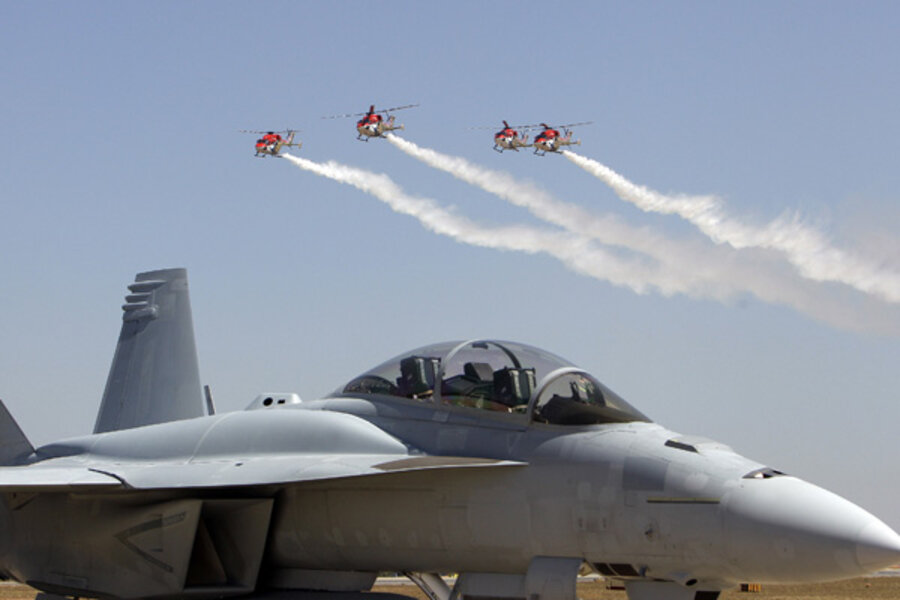US air power: Made in India?
Loading...
| Bangalore, India
B. Praveen beams as he explains why the molded magnesium jet part in front of him represents a major step forward for Indian aeronautics – and coming competition for one of America's last bastions of high-end manufacturing jobs.
With his finger, he traces the tunnels underneath the metal surface that carry oil seamlessly through the block. Workers at Hindustan Aeronautics Ltd. (HAL) succeeded in pouring liquid magnesium into every swiss-cheese crevice before the metal hardened.
"In this industry, we don't do things for 'good enough.' We do things perfectly," says Mr. Praveen, a HAL representative at Aero India, Asia's largest air show. "Originally we had some tie-ups with some [global] companies. From that learning, we have started making our own."
India is on the prowl for another such tie-up: an international order for 126 jet fighters. The goal is the same: To learn quickly how to make them at home. The two US firms bidding for the deal see not only a multibillion-dollar sale, but a chance to eventually outsource more manufacturing work to lower-wage India.
"We have a global supply chain that looks at capabilities around the world," says Orville Prins, a vice president at Lockheed Martin. "We intend to build those relationships [in India] on a long-term basis and make them part of our team so we can be more globally competitive."
Boeing's lead executive on the bid, Rick McCrary, sees potential for Indian aerospace companies: "If they are cost-effective, they have every opportunity to become part of our supply chain." India already builds "significant components" for commercial aircraft for Boeing, he notes.
If a US firm lands the deal, new US-based jobs will follow – in the short term. Mr. Prins sees some 35,000 US-based jobs if India taps Lockheed-Martin's F-16.
India's maturing industry
But as India's industries mature, the more than 500,000 US jobs in the sector could be affected, just as the information-technology sector felt the pinch after the rise of India's computer services firms.
India is forcing the issue through a mechanism known as an offset, which it instituted in 2005. Any major purchase of foreign defense equipment triggers a requirement that a portion be spent in India. For the jet fighter deal, the 50 percent offset means half of the roughly $10 billion price tag must be spent here. With the third-largest defense procurement budget in Asia, according to Global Defense Offset Review, India can demand that.
Some 22 nations have set up offsets since 1999, according to Jane's. Brazil has used them since the 1970s to advance aeronautics know-how, helping Embraer become a player in business jets.
"While it is not easy to estimate the number of jobs that have been directly lost because of offset deals, anecdotal evidence suggests a serious impact," writes Owen Herrnstadt, in a paper for a union-supported think tank in Washington. "As advanced industries like aerospace spin off to other countries, opportunities for US development of new technologies will be lost."
Parts made more cheaply abroad can boost the long-term competitiveness of firms like Boeing and Lockheed against international competitors, says Ashley Tellis, author of a study on the jet fighter tender for the Carnegie Endowment for International Peace. "If they can integrate India in the supply chain, lowering ... costs without compromising quality, that's to their advantage," says Dr. Tellis. "By the time Indians get smart about how to make F-18s, Boeing will have hopefully made enough money to transition to the F-18's successor and ... stay one step ahead."
The winner of India's jet fighter contract is expected to be tapped later this year.
Some assembly required
HAL's executive director, T. Sudhakar Rao, says the vision is for India to master the technologies needed to supply its defense needs and eventually become a defense innovator and exporter. But absorbing the offset and running the main production line in India will be challenging, says an executive at one of the six international bidders for the deal.
Under the deal, India will gradually take over more of the jet's construction. An early phase would follow a bike-in-a-box model – some assembly required in India. Subsequent phases would call for more parts to be made in India. The executive says there's some hope that the Indians will stay with the bike-in-a-box approach if domestic skills don't catch up. The 50 percent offset could be fulfilled through various alternative mechanisms.
Others see the possibility of India becoming an outsourcing location, but think it early to talk of it becoming an international developer. "The way the government is moving, I give it seven to 10 years ... [before] they would be ... counted as world-class manufacturers in their own right, rather than be piggybacking on foreign companies," says retired Maj. Gen. Mrinal Suman, who managed the Air Force team that formulated India's recent defense procurement policy.
Back at Aero India, Praveen lets on that some of HAL's technology is aspirational. Standing in front of a display of jet parts, he says: "Frankly speaking, some of these castings are coming from abroad and we are [just] machining them. Machining is simpler."





